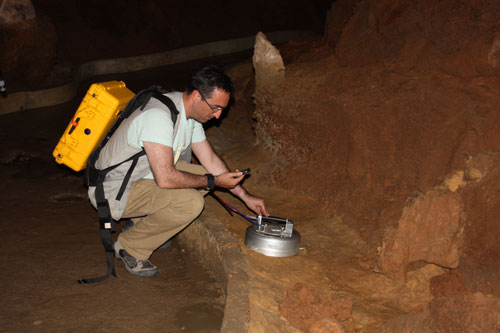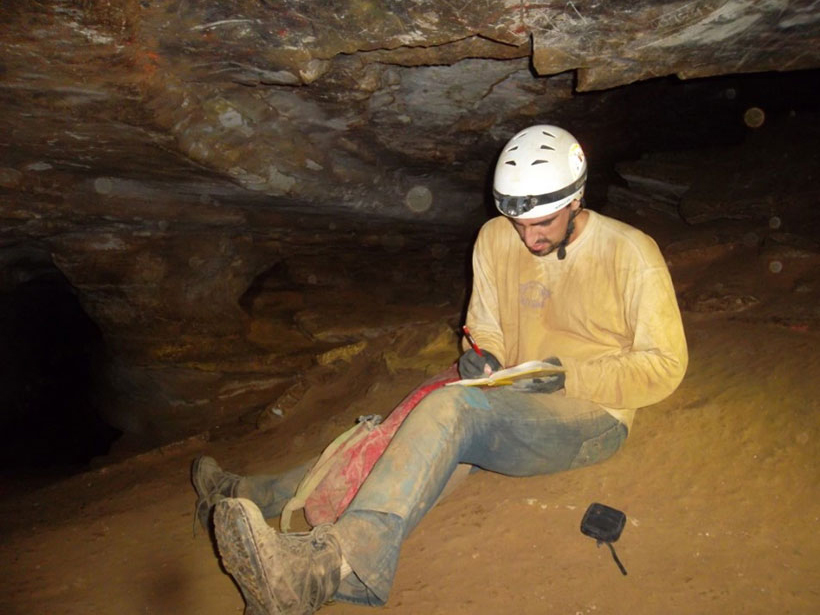Caves may be dark and eerie, but now they are a little less mysterious. That is, at least, when it comes to what happens to the atmospheric methane that enters the caves.
Researchers recently completed the most extensive published study to date of methane concentrations in karst caves. Cave environments are a global sink for methane, they assert, but other scientists have voiced some reservations about that claim.
Scientists conducting those initial explorations expected to find higher methane concentrations inside the caves than in the surrounding atmosphere, but they found the opposite.
Karst terrains, such as caves, sinkholes, and other formations pockmarked by internal voids, form when soluble rocks such as limestone erode. The most widespread karst caves form when carbon dioxide dissolves in surface waters, creating carbonic acid that disintegrates the limestone. Caves and other karst environments underlie about 14% of Earth’s land, and it’s not well known how this terrestrial subsurface interacts with the atmosphere, said independent biogeochemist Kevin Webster of Tucson, Ariz., who led the new study and was formerly with the University of Arizona in Tucson.
Methane is a potent greenhouse gas, and its concentration in the atmosphere is increasing. Scientists are tracing methane’s sources and sinks to help them understand the rate and expected amount of the gas’s accumulation in our planet’s atmosphere.
Within the past decade, investigators started measuring methane levels in a few caves and associated karst landscapes. The scientists conducting those initial explorations expected to find higher methane concentrations inside the caves than in the surrounding atmosphere, but they found the opposite, according to Webster.

To find out if methane depletion is unique to only a handful of caves, Webster and his colleagues recently measured the air inside 33 karst caves in the United States and 3 caves in New Zealand, essentially tripling the known data set. From May 2012 to September 2016, they measured methane concentrations, as well as ratios of stable carbon and hydrogen isotopes in the methane. Supporting measurements provided information on the cave air residence times and mixing processes.
Thirty-five, or 97%, of the tested caves had methane concentrations lower than those in the outside atmosphere in at least one measurement location, the researchers report in the 1 March issue of Earth and Planetary Science Letters (EPSL).
Methane Eaters
So what’s happening to the methane?
Earlier karst cave studies that initially observed the methane depletion proposed two main hypotheses: Methane is oxidized by ions and radicals from the radioactive decay of radon, or methane is consumed by methane-eating microorganisms. However, the researchers doing those studies couldn’t conduct all the measurements needed to distinguish between the two, Webster noted, whereas he and his colleagues made special provisions to collect the essential data.
The researchers found the isotopic signature of methanotrophic bacteria, which led them to conclude that those bacteria were the cause of the methane loss.
For instance, he and his team report in the EPSL paper, which was first published online on 8 January, that they measured the hydrogen isotope ratios of their methane samples, which had not been done previously in these cave environments, according to Webster. To be able to do so, Webster told Eos, the scientists custom built an inlet for a gas chromatograph–isotope ratio mass spectrometer and used the inlet to preconcentrate the methane. “Preconcentration is necessary because methane is at such low abundance in air” and even less abundant in cave air, Webster explained. Ultimately, the researchers found the isotopic signature of methanotrophic bacteria, which led them to conclude that those bacteria were the cause of the methane loss.
The scientists’ novel approach also helped them to solve another mystery. It turns out that the team observed at least two sources of methane entering some of the caves: The main source was the atmosphere outside of the cave, but a minor contribution also came from two different microbial biochemistries. “That was very surprising,” said Webster, given that researchers have previously observed such processes co-occurring only in lake or fen environments.
David Mattey, an isotope geochemist at Royal Holloway, University of London, in the United Kingdom, saluted the advance of using hydrogen isotopes to fingerprint different methanogenic sources. Mattey, an original proposer of the microbial depletion pathway who was not involved with the new cave study, noted that the findings by Webster and his team confirm his earlier work.

Global Sink
The fact that nearly all of the studied caves consumed methane suggests to Webster that caves in general do the same. “There is nothing unusual about methane consumption in caves or the minor processes of methane production we observed,” he said. On the basis of their measurements, he and his coauthors contend in their paper that karst environments reduce methane’s atmospheric concentrations worldwide. Because the microbial sources of methane were minor, those emissions did little to offset the net loss of methane in the caves. The next step is to figure out how large the losses are, Webster said.
Mattey needs more evidence. “You have to be careful claiming that it might have a global impact,” he said, “because it’s very, very difficult to upscale it from just one or two measurements.” He advised more long-term monitoring as well as reaching a better understanding of fluxes and how the caves are connected to the atmosphere.
—Laura G. Shields ([email protected]; @LauraGShields), Science Communication Program Graduate Student, University of California, Santa Cruz
Citation:
Shields, L. G. (2018), Some caves remove methane from the atmosphere, new tests reveal, Eos, 99, https://doi.org/10.1029/2018EO094275. Published on 05 March 2018.
Text © 2018. The authors. CC BY-NC-ND 3.0
Except where otherwise noted, images are subject to copyright. Any reuse without express permission from the copyright owner is prohibited.

